1991 OPEL ASTRA fuel pressure
[x] Cancel search: fuel pressurePage 1031 of 1070
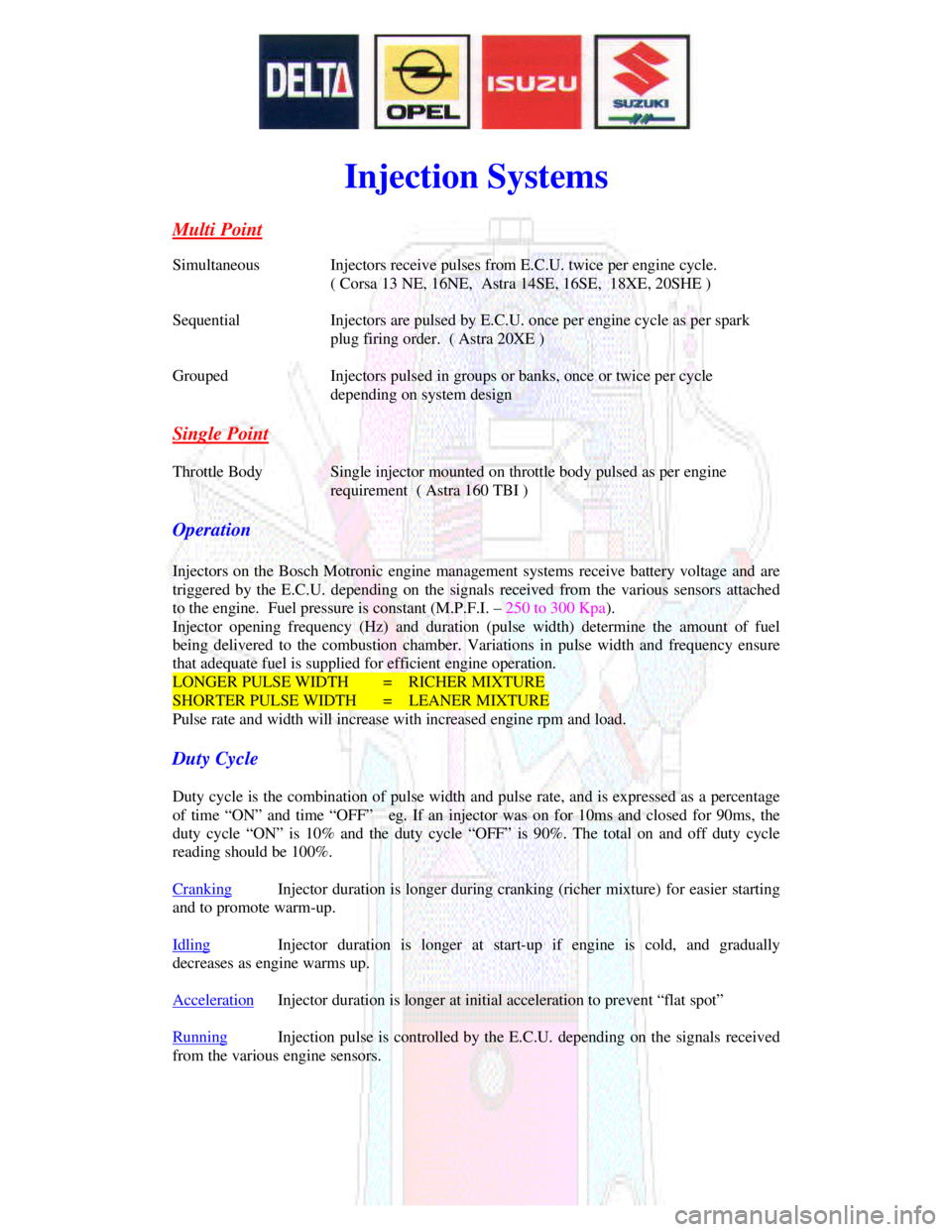
Downloaded from www.Manualslib.com manuals search engine Injection Systems
Multi PointSimultaneousInjectors receive pulses from E.C.U. twice per engine cycle.
( Corsa 13 NE, 16NE, Astra 14SE, 16SE, 18XE, 20SHE )
SequentialInjectors are pulsed by E.C.U. once per engine cycle as per spark
plug firing order. ( Astra 20XE )
GroupedInjectors pulsed in groups or banks, once or twice per cycle
depending on system design
Single PointThrottle BodySingle injector mounted on throttle body pulsed as per engine
requirement ( Astra 160 TBI )
Operation
Injectors on the Bosch Motronic engine management systems receive battery voltage and are
triggered by the E.C.U. depending on the signals received from the various sensors attached
to the engine. Fuel pressure is constant (M.P.F.I. – 250 to 300 Kpa).
Injector opening frequency (Hz) and duration (pulse width) determine the amount of fuel
being delivered to the combustion chamber. Variations in pulse width and frequency ensure
that adequate fuel is supplied for efficient engine operation.LONGER PULSE WIDTH= RICHER MIXTURESHORTER PULSE WIDTH= LEANER MIXTURE
Pulse rate and width will increase with increased engine rpm and load.
Duty Cycle
Duty cycle is the combination of pulse width and pulse rate, and is expressed as a percentage
of time “ON” and time “OFF” eg. If an injector was on for 10ms and closed for 90ms, the
duty cycle “ON” is 10% and the duty cycle “OFF” is 90%. The total on and off duty cycle
reading should be 100%.
CrankingInjector duration is longer during cranking (richer mixture) for easier startingand to promote warm-up.
IdlingInjector duration is longer at start-up if engine is cold, and graduallydecreases as engine warms up.
AccelerationInjector duration is longer at initial acceleration to prevent “flat spot”RunningInjection pulse is controlled by the E.C.U. depending on the signals receivedfrom the various engine sensors.
Page 1032 of 1070
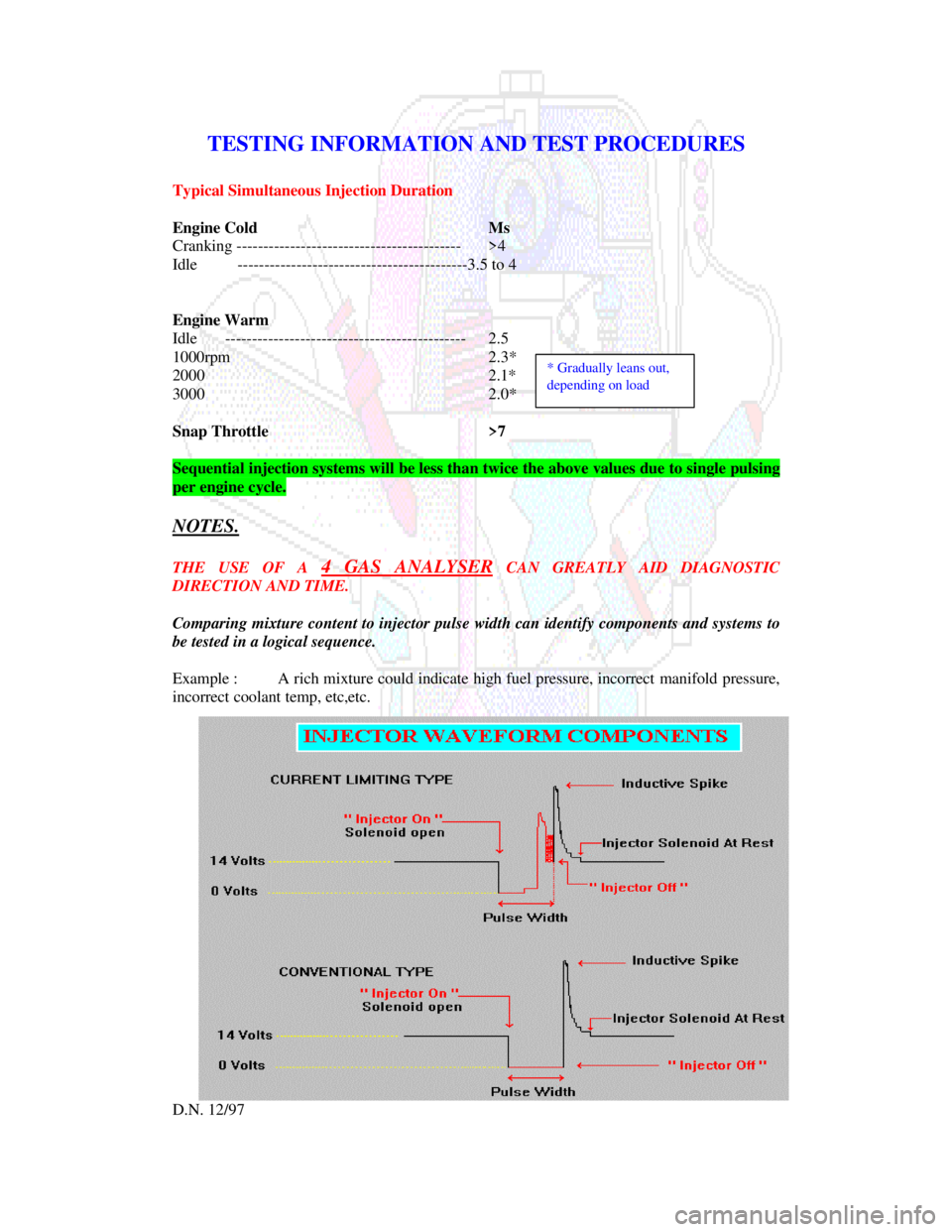
Downloaded from www.Manualslib.com manuals search engine TESTING INFORMATION AND TEST PROCEDURES
Typical Simultaneous Injection Duration
Engine ColdMs
Cranking ------------------------------------------>4
Idle -------------------------------------------3.5 to 4
Engine Warm
Idle---------------------------------------------2.5
1000rpm2.3*
20002.1*
30002.0*
Snap Throttle>7Sequential injection systems will be less than twice the above values due to single pulsingper engine cycle.
NOTES.THE USE OF A 4 GAS ANALYSER CAN GREATLY AID DIAGNOSTICDIRECTION AND TIME.
Comparing mixture content to injector pulse width can identify components and systems to
be tested in a logical sequence.
Example :A rich mixture could indicate high fuel pressure, incorrect manifold pressure,
incorrect coolant temp, etc,etc.
D.N. 12/97* Gradually leans out,depending on load
Page 1036 of 1070
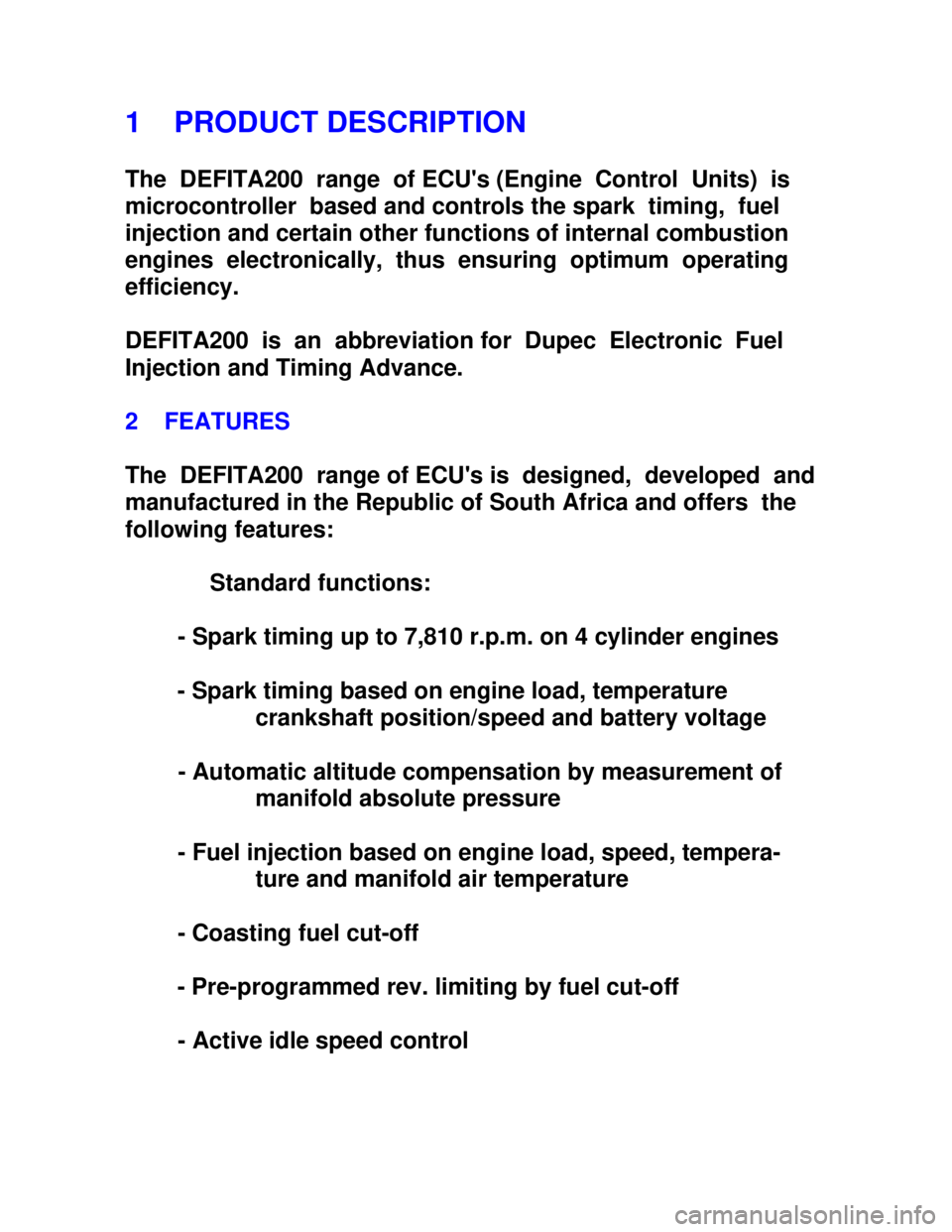
Downloaded from www.Manualslib.com manuals search engine 1 PRODUCT DESCRIPTION
The DEFITA200 range of ECU's (Engine Control Units) is
microcontroller based and controls the spark timing, fuel
injection and certain other functions of internal combustion
engines electronically, thus ensuring optimum operating
efficiency.
DEFITA200 is an abbreviation for Dupec Electronic Fuel
Injection and Timing Advance.
2 FEATURES
The DEFITA200 range of ECU's is designed, developed and
manufactured in the Republic of South Africa and offers the
following features:
Standard functions:
- Spark timing up to 7,810 r.p.m. on 4 cylinder engines
- Spark timing based on engine load, temperature
crankshaft position/speed and battery voltage
- Automatic altitude compensation by measurement of
manifold absolute pressure
- Fuel injection based on engine load, speed, tempera-
ture and manifold air temperature
- Coasting fuel cut-off
- Pre-programmed rev. limiting by fuel cut-off
- Active idle speed control
Page 1041 of 1070
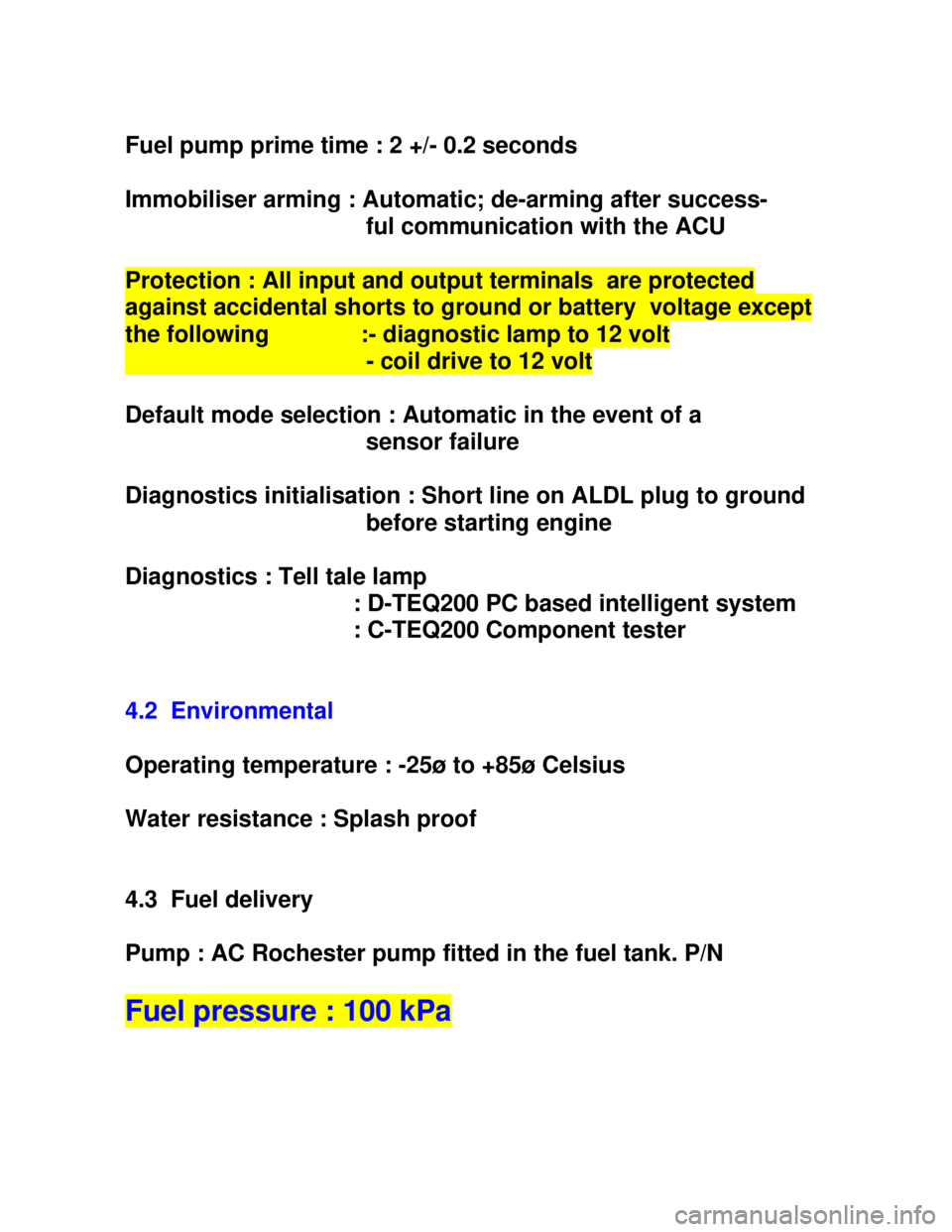
Downloaded from www.Manualslib.com manuals search engine Fuel pump prime time : 2 +/- 0.2 seconds
Immobiliser arming : Automatic; de-arming after success-
ful communication with the ACUProtection : All input and output terminals are protectedagainst accidental shorts to ground or battery voltage exceptthe following :- diagnostic lamp to 12 volt - coil drive to 12 volt
Default mode selection : Automatic in the event of a
sensor failure
Diagnostics initialisation : Short line on ALDL plug to ground
before starting engine
Diagnostics : Tell tale lamp
: D-TEQ200 PC based intelligent system
: C-TEQ200 Component tester
4.2 Environmental
Operating temperature : -25ø to +85ø Celsius
Water resistance : Splash proof
4.3 Fuel delivery
Pump : AC Rochester pump fitted in the fuel tank. P/NFuel pressure : 100 kPa
Page 1046 of 1070
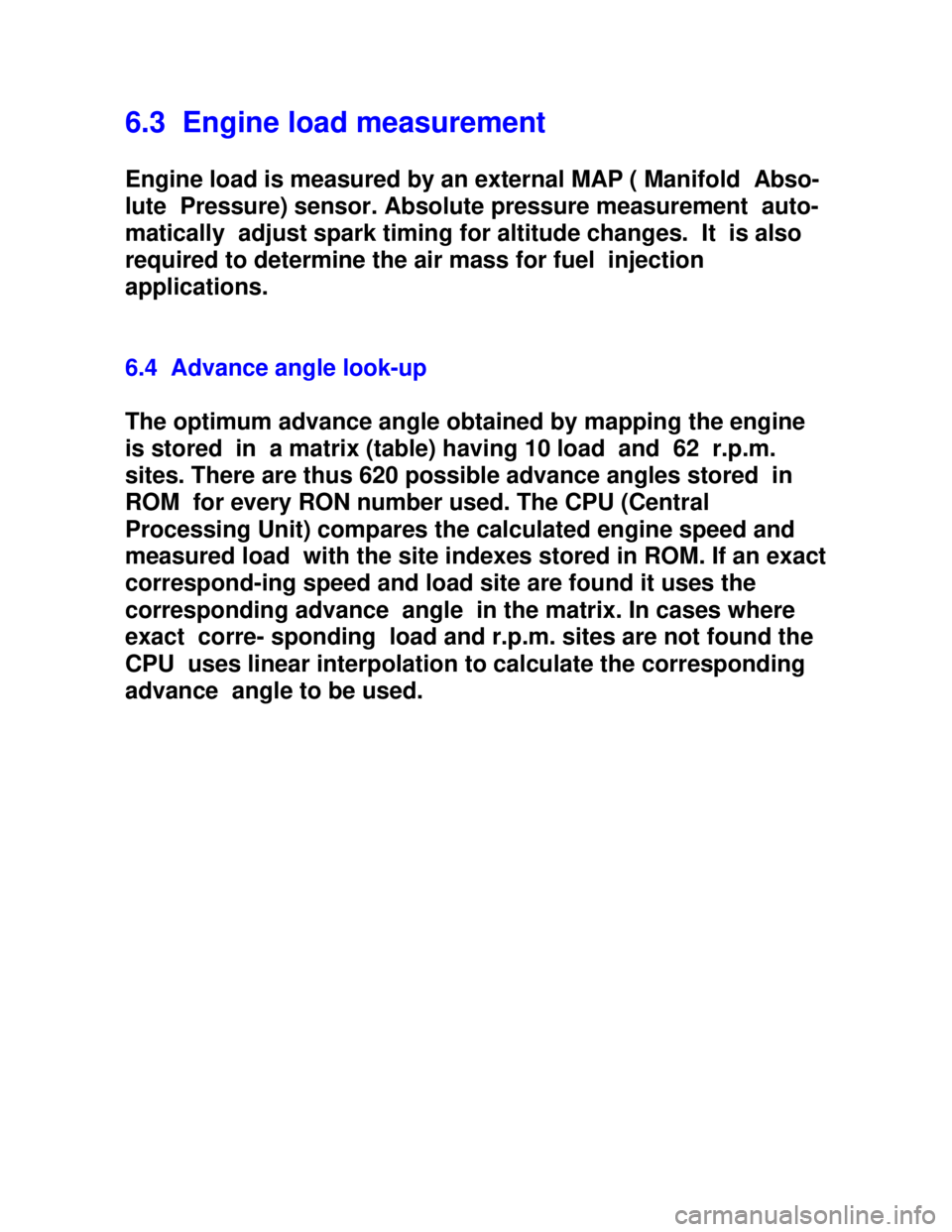
Downloaded from www.Manualslib.com manuals search engine 6.3 Engine load measurement
Engine load is measured by an external MAP ( Manifold Abso-
lute Pressure) sensor. Absolute pressure measurement auto-
matically adjust spark timing for altitude changes. It is also
required to determine the air mass for fuel injection
applications.
6.4 Advance angle look-up
The optimum advance angle obtained by mapping the engine
is stored in a matrix (table) having 10 load and 62 r.p.m.
sites. There are thus 620 possible advance angles stored in
ROM for every RON number used. The CPU (Central
Processing Unit) compares the calculated engine speed and
measured load with the site indexes stored in ROM. If an exact
correspond-ing speed and load site are found it uses the
corresponding advance angle in the matrix. In cases where
exact corre- sponding load and r.p.m. sites are not found the
CPU uses linear interpolation to calculate the corresponding
advance angle to be used.
Page 1052 of 1070

Downloaded from www.Manualslib.com manuals search engine 7.3 SPEED DENSITY CONCEPT
If we know the density of the air inside a container it is
possible to calculate the exact mass of the air inside the
container.
Am = Va*p Where Am = Air mass (g)
Va = Air volume (cc)
p = Air density (g/cc)
In an automotive FI application the quantity of fuel to be
injected can be calculated if the displacement volume of the
cylinder and the density of air within the cylinder at the
onset of the compression stroke are known.
The air density could be determined by measuring the abso-
lute pressure and absolute temperature of the air. In an
automotive application it is, however, not practical to
directly measure the air pressure and temperature inside the
cylinder. To overcome this limitation the air pressure and
temperature are measured in the inlet manifold. This leads
to certain pressure measurement errors for which corrections
have to be made.
To understand and correct these errors the engine is mo-
delled as an air pump. For the purpose of explaining these
problems one has to view the engine as a pump sucking air
from the inlet manifold through a restriction which is
formed by the inlet valve in the open position. The dynamic
properties of the air moving past the inlet valves are
engine speed dependent and to such an extent that the inlet
manifold pressure will tend to be slightly higher than the
in-cylinder pressure at the end of an inlet stroke. This
leads to higher than actual air mass measurements which
have
to be corrected. The air pumping efficiency is called the
volumetric efficiency of the engine.
Page 1053 of 1070

Downloaded from www.Manualslib.com manuals search engine Volumetric efficiency depends mainly on the:
a) Inlet valve and camshaft design
b) Inlet manifold design
c) Engine speed
The volumetric efficiency is normally less than one (1) and
has the effect that the actual air mass entering the cylin-
der will be less than the measured value.
Peak volumetric efficiency co-insides with the engine speed
where the maximum torque is developed.
7.4 FUEL METERING
Now that a method has been established to determine the air
mass entering the engine it is possible to calculate the
quantity of fuel to be injected to achieve the required A/F
ratio. An electric fuel pump delivers fuel at a constant
pressure to the injector which is opened for the required
injection duration. The fuel pressure is regulated by a
mechanical pressure regulator.
The fuel mass to be injected is:
Fm = Am/(A/F) Where Fm = Fuel mass
Am = Air mass
Since the fuel is injected in bursts it is necessary to know
the fuel flow rate of the injector, pump and regulator
system, as well as the injector opening and closing delays
at various battery voltages to enable calculation of the
injection duration.
Page 1054 of 1070
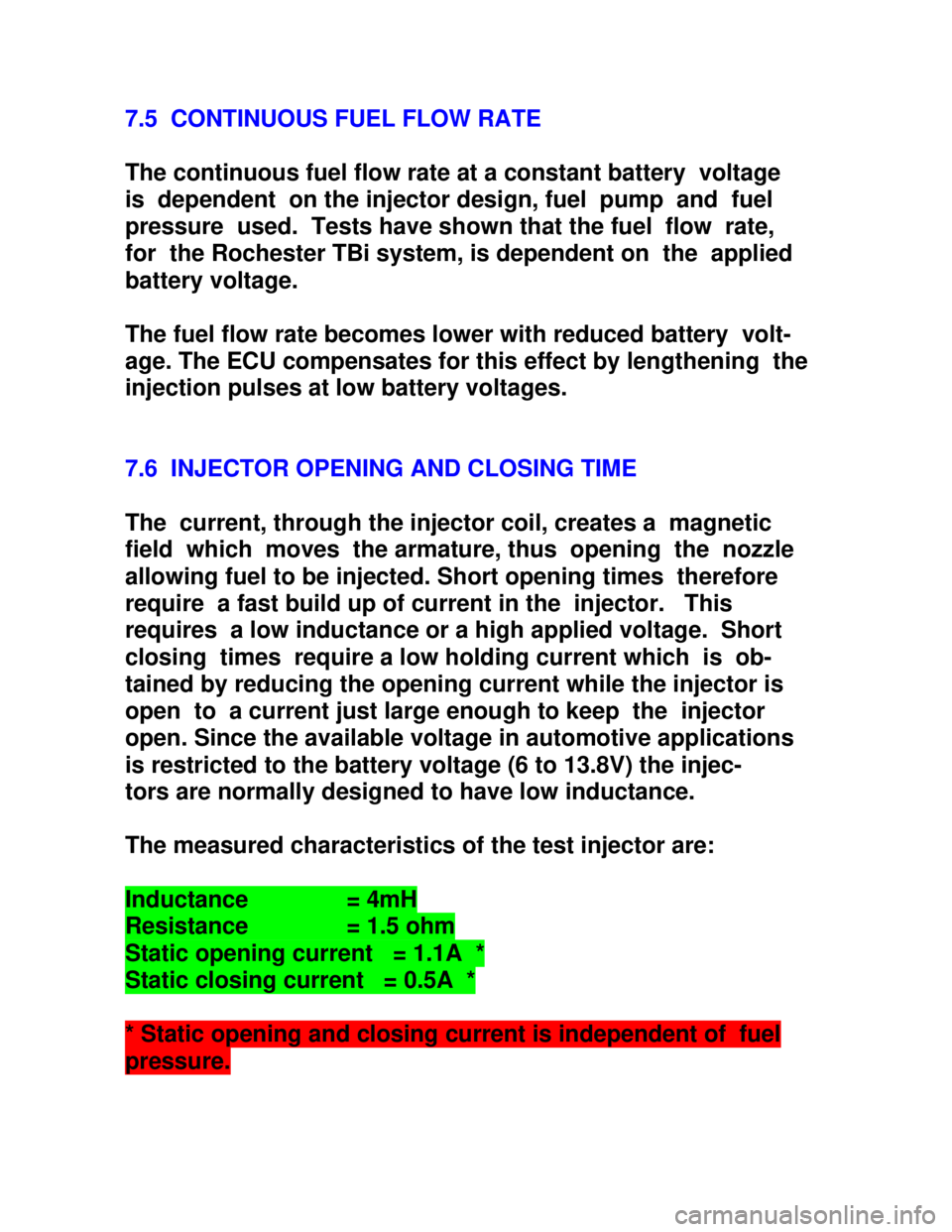
Downloaded from www.Manualslib.com manuals search engine 7.5 CONTINUOUS FUEL FLOW RATE
The continuous fuel flow rate at a constant battery voltage
is dependent on the injector design, fuel pump and fuel
pressure used. Tests have shown that the fuel flow rate,
for the Rochester TBi system, is dependent on the applied
battery voltage.
The fuel flow rate becomes lower with reduced battery volt-
age. The ECU compensates for this effect by lengthening the
injection pulses at low battery voltages.
7.6 INJECTOR OPENING AND CLOSING TIME
The current, through the injector coil, creates a magnetic
field which moves the armature, thus opening the nozzle
allowing fuel to be injected. Short opening times therefore
require a fast build up of current in the injector. This
requires a low inductance or a high applied voltage. Short
closing times require a low holding current which is ob-
tained by reducing the opening current while the injector is
open to a current just large enough to keep the injector
open. Since the available voltage in automotive applications
is restricted to the battery voltage (6 to 13.8V) the injec-
tors are normally designed to have low inductance.
The measured characteristics of the test injector are:Inductance = 4mHResistance = 1.5 ohmStatic opening current = 1.1A *Static closing current = 0.5A ** Static opening and closing current is independent of fuelpressure.